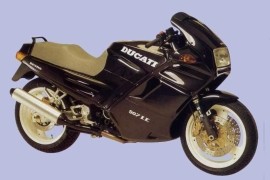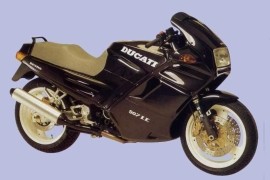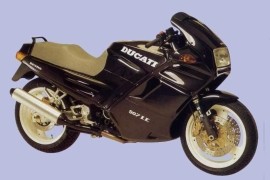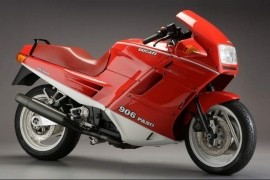DUCATI Paso Models/Series Timeline, Specifications & Photos
First production year: 1989
The Ducati 907ie was a fully faired motorcycle of the Ducati Paso range. The Ducati Paso was the first motorcycle manufactured after the Cagiva group took over the brand. The bike was available in three versions, including the 750 Paso, Paso 906, and 907ie.
The Ducati 907ie debuted in 1990 and was presented at the 1990 Cologne Motorcycle Show. The Ducati 907ie featured a new fuel injection system that improved power and dropped the Paso designation.
In 1992, the Italian motorcycle manufacturer launched the Ducati 907ie, a motorcycle in its third year of production that followed the same recipe as the first model without any significant modifications.
The bike packed the same standard features as its predecessors, such as a full fairing with a small windscreen, a rectangular headlight, a one-piece dual seat with a passenger grab handle, a dual exhaust system with a muffler on each side, and three-spoke aluminum wheels.
In the performance department, the 1992 Ducati 907ie packed a 907cc four-stroke liquid-cooled V-twin engine with a new fuel injection system in charge, delivering an output power of 90 hp with a peak force at 8,500 rpm and 85 Nm (63 lb-ft) torque at 5,000 rpm.
The braking performance was achieved by two 300 mm discs with two-piston calipers on the front wheel and a 245 mm disc with a dual-piston caliper on the rear wheel, offering optimum stopping power.
In 1991, the Italian motorcycle manufacturer launched the Ducati 907ie, a fully faired motorcycle and a more advanced version of the 906 standard model. Compared to the standard machine, the 907ie was slightly modified in the engine department.
The 1991 Ducati 907ie was in its second year of production and came with a new fuel injection system that improved output performance but also came without the Paso designation, which dropped at its release in 1990.
In the visual department, the bike was similar to the standard model, packing standard features, such as a full fairing, a small windscreen, a rectangular headlight, a one-piece dual seat with a passenger grab handle, a dual exhaust system with a muffler on each side, and three-spoke lightweight aluminum wheels.
On the front end, the bike packed a 42 mm Marzocchi upside-down fork for suspension and two 300 mm discs with two-piston calipers for stopping power. In contrast, the rear end was handled by an adjustable shock absorber and a 245 mm disc with a dual-piston caliper.
In the performance department, the 1991 Ducati 907ie had its soul brought to life by a 907cc four-stroke liquid-cooled V-twin engine fed by an Electronic Fuel Injection (EFI) system, delivering 90 hp with a peak force at 8,500 rpm.
The bike's power was transferred to a six-speed manual transmission with a dry multi-plate clutch and a final chain drive, pushing the motorcycle to 230 kph (143 mph).
The Ducati Paso was a fully faired motorcycle and the first machine produced by Ducati after the brand was taken by the Cagiva group. The Ducati Paso was manufactured in three versions, including the 750 Paso created in 1986, the Paso 906 made in 1988, and the 907ie made in 1990.
In 1990, the Italian motorcycle manufacturer launched the Ducati 907ie, a machine presented at the 1990 Cologne Motor Show that brought several modifications and improvements compared to the standard model.
First of all, the bike lost the Paso designation, and second, the bike retained the same engine as the standard model but with a new fuel injection system instead of the previously used carburetor, which solved the fuel supply problems of the previous version.
In the aesthetic department, the bike had the same standard features as the base model, with a full fairing, a small windscreen, a rectangular headlight, a one-piece dual seat with a passenger grab rail, a dual exhaust system with a muffler on each side, and new three-spoke aluminum wheels.
As for the power figures, the 1990 Ducati 907ie packed the same 907cc four-stroke liquid-cooled V-twin power plant as the standard model with a new electronically-controlled fuel injection system, boasting 90 hp at 8,500 rpm and 85 Nm (63 lb-ft) torque at 5,000 rpm.
The Ducati Paso was the first motorcycle manufactured by the Italian maker after the acquisition of the brand by the Cagiva group. The bike was presented in November 1985 at the Milan Show and produced in three versions: the 750 Paso made in 1986, the Paso 906 made in 1988, and the 907IE made in 1990.
The Paso name was taken from the Renzo Pasolini pilot, also known as Paso. The racer died on May 20, 1973, in an accident at the Monza racetrack during the Nations Grand Prix race.
In 1989, the Italian motorcycle manufacturer launched the Ducati 906 Paso, a bike presented at the 1988 Cologne Motor Show. The bike was powered by a 904cc engine that pushed the bike to 220 kph (134 mph) and was characterized by a liquid-cooling system and a six-speed gearbox.
In the visual department, the bike presented a full fairing with a small windscreen, a rectangular headlight, a single-piece dual seat with a passenger grab handle, a dual exhaust system with a muffler on each side, and triangular-shaped three-spoke aluminum wheels.
Underneath its fairing, the 1989 Ducati 906 Paso had hidden from plain sight a 904cc four-stroke liquid-cooled V-twin engine with a carburetor feeding the pistons, delivering 84 hp with a peak at 8,500 rpm and 85 Nm (63 lb-ft) torque at 5,000 rpm.



